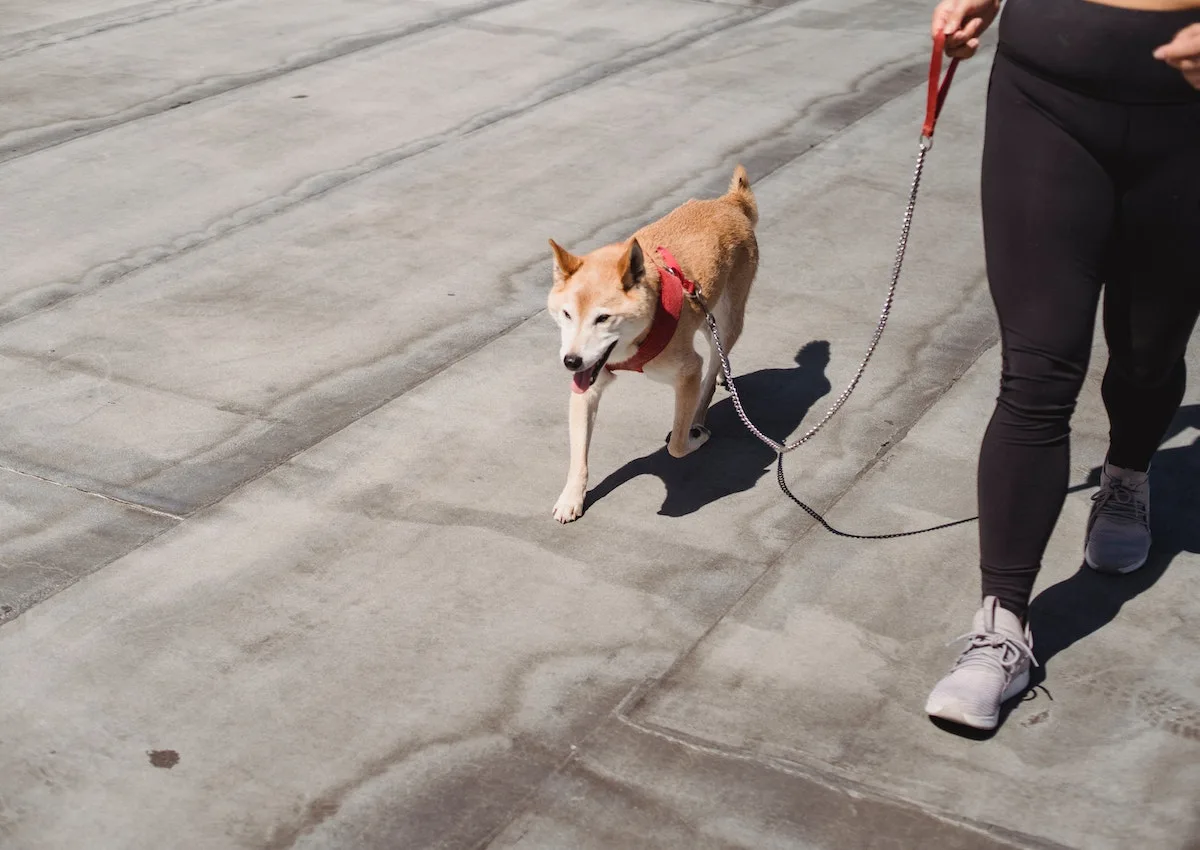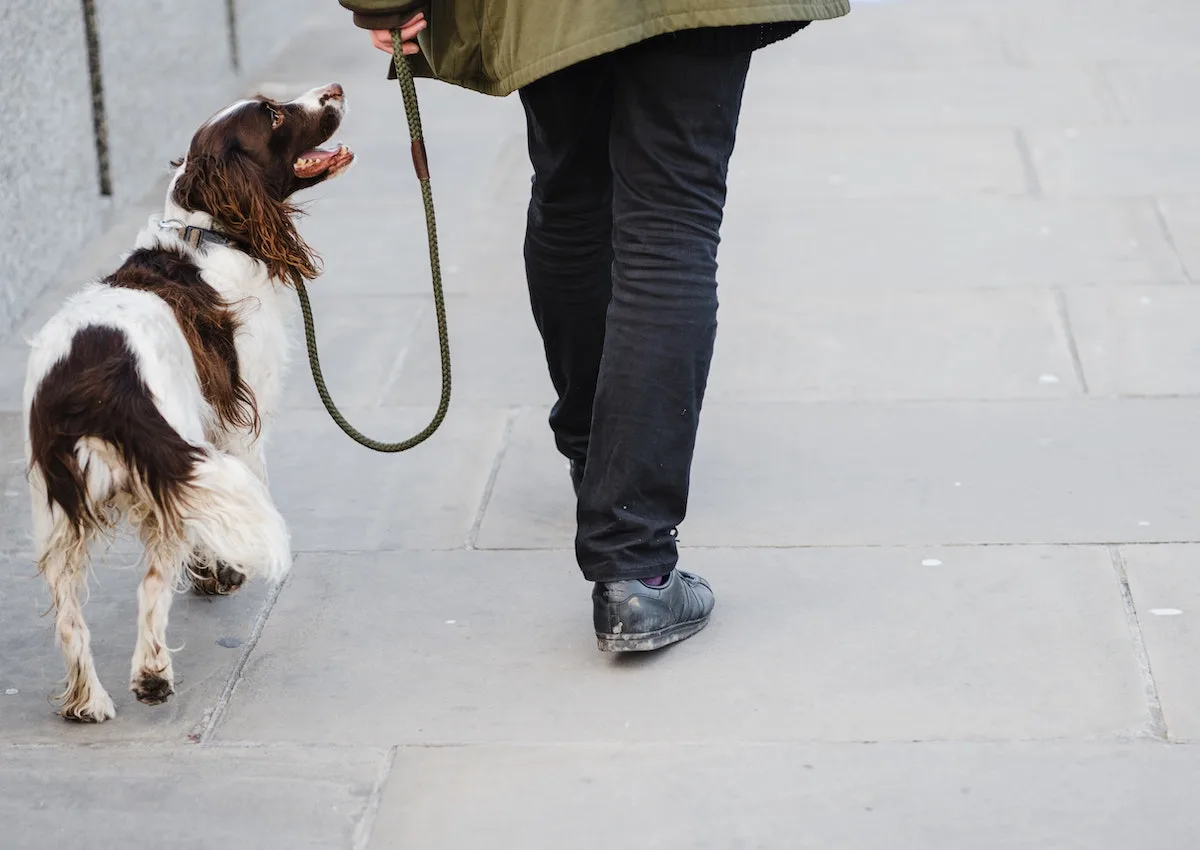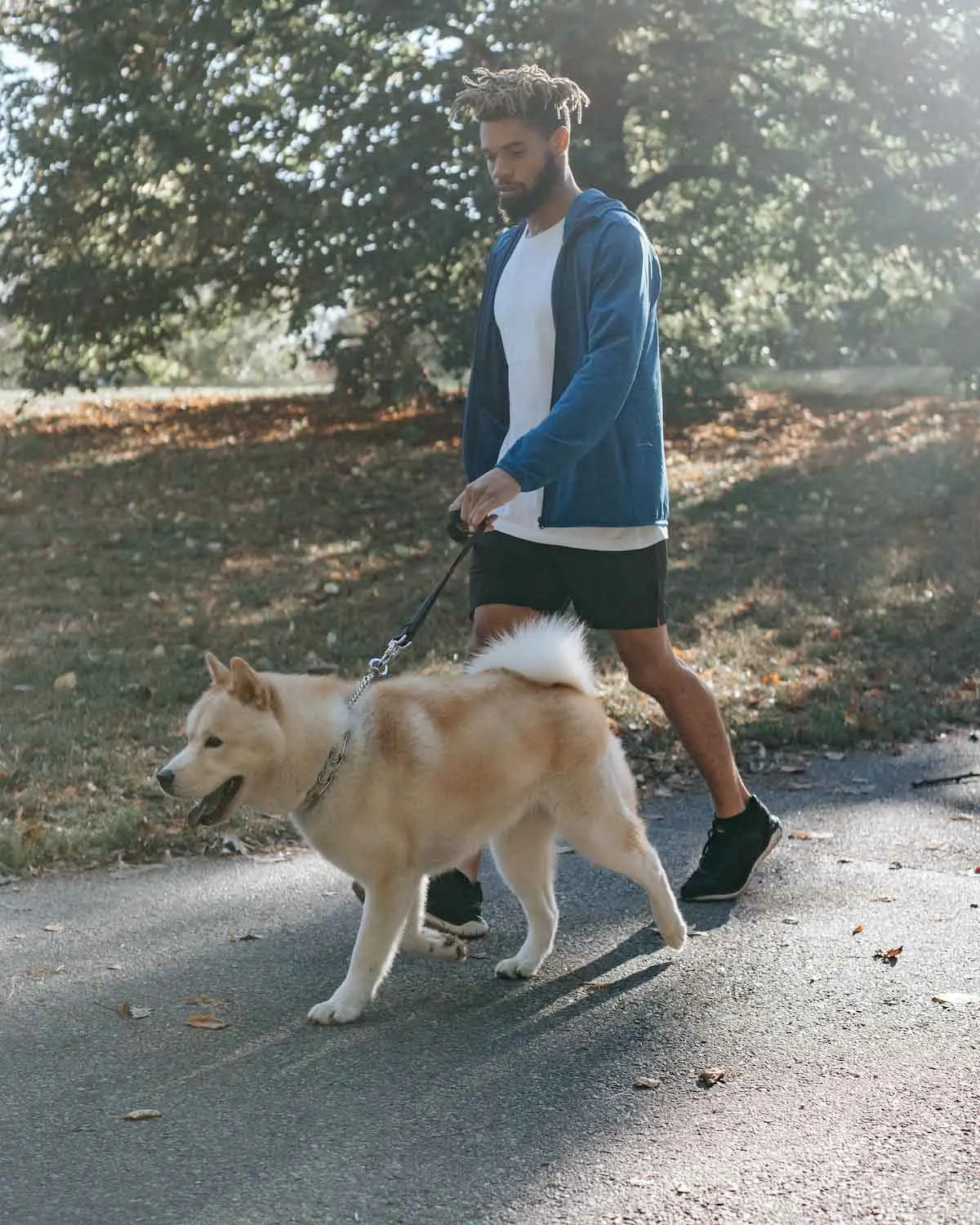Training your dog to walk on a leash is essential for day to day life as a dog owner. We’ve all seen people walking down the street being pulled around by their dog. The dog taking the owner for a walk versus the other way around.

This post may contain affiliate link(s). As an Amazon Associate, I earn from qualifying purchases.
This guide will provide a comprehensive method on how to train a dog to walk on a leash, covering techniques, equipment and troubleshooting tips for a successful walking experience.
Choosing the right equipment
The first step of training your dog how to walk on a leash is to understand each piece of equipment you put on your dog. This includes the collar, harness and leash.
There are many collars available for your dog and understanding them is important.
When placing a collar on the dog it should be loose enough to be able to rotate with ease but not so loose it can slip off the dog while pulling against leash pressure.
More importantly, however, is understanding the dog you are training. Some dogs are more reactive to leash corrections then others. We’ll assume we’re working with the the average dog. If your dog is more sensitive or stubborn like a Dutch Shepherd or Belgian Malinois, adjust accordingly.
Flat collars
Flat collars are not going to inhibit your dog from pulling whatsoever. They offer an easy way to grab the dog when they are off leash but if you want to train a dog to walk on a leash properly, it’s best to avoid flat collars. They don’t allow you to apply any corrective stimulus to the dog when it begins to pull.
Choke collars
Choke collars can apply corrective stimulus to the dog during a leash walk but they also have a tendency to remove the hair around the dog’s neck. They work better than a flat collar but aren’t the clearest tool to use especially for stubborn dogs.
Herm Sprenger collars
Herm Sprenger prong collars are the preferred training collar for teaching a dog to walk on a leash. These collars allow you to apply far fewer corrections in the beginning of training to teach the dog where it needs to be while walking and act as a clear communicating device between the handler and dog.
The fit of the collar is always important but even more so with this type of collar. The collar should be loose enough you can easily spin it around the dogs neck but not so loose the dog can pull out of it.
Head collars or harnesses
Head collars or harnesses are another option. You will not be able to apply a leash correction to a dog with one of these but you probably won’t have to.
While these options can work, they don’t necessarily train the dog to walk on a leash but rather prevent them from pulling. Head collars also won’t work for dogs with short snouts such as pugs or bulldogs.
Leashes
As far as the leash itself, it’s really up to what you prefer to hold (leather or biothane vs. nylon or rope). Length of the leash does matter. A 4 foot leash this a great length for training purposes. It gives the dog enough room to step away from you and not be crowded but not too much where they can get ahead of you before you can correct them.

Introducing the leash
If you haven’t already introduced a leash and collar to the dog, take some time putting both on and rewarding them with food to desensitize and form a positive association with the equipment.
As you begin to train the dog to walk on a leash it’s important to remember to reward the behavior you want and not tolerate the behavior you don’t. This needs to be consistent, it’s only fair if we communicate consistently what we are expecting and or what we will not tolerate.
Finding the appropriate environment
Find an area with few distractions. For example, you wouldn’t want to start in a busy park with kids playing, screaming and throwing balls around. This environment will offer too many opportunities for the dog to become stimulated and pull toward whatever that stimulus is.
A quiet fenced in yard with no other animals or a quiet dead end road with no traffic are ideal places to teach this. You should have a treat pouch, ideally on your left side where the dog will be, so you can deliver a reward and positively reinforce good behavior.
Why the left side? Reasons include being able to quickly reward straight down to the dog and not across your body. Rewarding the dog quickly limits the tendency for the dog to get ahead of you and pull on the leash. They will want to keep their head close to that pouch to get it quicker. If the pouch is on the right side they are more likely to cross in front of you trying to get to the source of their treats.

How to train a dog to walk on a leash: step by step process
Begin with holding the leash at the end to allow the dog to utilize the full four feet. Your hands should be close together with your right hand palm facing up and your left hand palm facing down. They should be kept tight close to where your belt buckle would be. This provides you with good support depending on the size of the dog you are training.
As you walk and the dog is in the correct position (left of you and not ahead of you pulling the leash tight) you will want to mark the good behavior using either a verbal marker such as “Yes!” or a training clicker. Immediately after marking the behavior, deliver a treat down to the dog. This is called operant conditioning and the same method you would use when bell training a dog.
Something as simple as giving the dog a treat can create other issues so let’s discuss reward placement. You want to reward the dog in the position you want them to walk in.
For me, I like the dog’s shoulders when walking (not in a heel) to be just forward of my left knee. This allows me to keep an eye on them with my peripheral vision. If I see them begin to sniff something or try to eat something they shouldn’t I can offer a correction (either verbal or a physical) and keep them moving.
So when you deliver the treat it will be straight down from the treat pouch to the left knee allowing the dog to take the treat while its head is facing forward not sideways. This placement also helps keep them from forging ahead.
Think of their body as a straight line, if you begin rewarding them while their head is sideways their body will also begin to turn sideways and they will start crabbing or walking sideways.

Troubleshooting common issues of leash training
There are a few common issues you’re likely to experience when beginning leash training with your dog.
What to do when the dog begins to pull forward on the leash
Understand the dog will have what is called an opposition reflex and want to pull away from a tight collar. So if you walk with a tight leash the dog actually will continue to try to pull forward and free from that situation. See the dilemma here?
The correction to this behavior is to simply change directions by doing an immediate and sudden 180 degree turn on your heels and start walking in the opposite direction whenever the dog begins to pull ahead on the leash.
It cannot be stressed enough that it’s important to walk in straight lines when doing this otherwise the dog may begin to turn you back in the other direction they wanted to go without you even realizing it.
If you do this properly, as you turn and start walking in the other direction the leash will put a sudden and quick pressure on the collar which will cause the dog to turn with you to avoid that unpleasant feeling. This is a very quick and sudden action when done correctly and will surprise the dog.
Continue walking in this new direction and if the dog is walking without pulling, give a reward. If the dog begins to pull again you will repeat this, turning back suddenly the other way. Through this repetition you will train the dog to not pull on the leash and pay attention to you.
You may find yourself doing several quick turns in the beginning. That’s ok. Just focus on where the dog is and try to help them get in the correct position so you can reward them for it.

How to handle dogs that jump when you walk them on a leash
To address jumping while walking on a leash, the best option is to apply a sudden and immediate downward tug on the leash as soon as the dog begins to perform this behavior paired with a stern “No”.
Do not stop walking while you do this, by stopping you will make it an event which the dog can then extract the attention they were looking for. Once again, reward them with food when they are walking in the correct position.
Dogs that bite the leash
Another issue that can arise is when a dog becomes reactive to the leash and begins to bite it. This behavior must be immediately stopped or it can manifest and become harder to extinguish.
If the dog begins biting the leash you will need to apply a light side correction with a stern “No”. Do not stop walking as this again will make this an event.
Once the dog is no longer biting the leash and is walking properly, positively reinforce that behavior with a treat. If this behavior occurs and you are not able to extinguish it you may need to consult a reputable dog trainer.
Conclusion
Training your dog to walk on a leash is really about communicating to the dog what you will tolerate and what you will not. You must be consistent with this for it to be clear to the dog. Set goals for distance and keep training sessions short. If you or the dog become frustrated, take a break or just end it for the day and start the next session fresh.
By following this guide, utilizing positive reinforcement, and maintaining patience and consistency, you can transform your dog’s leash walking experience from a struggle to an enjoyable and harmonious activity for both of you. Even the dumbest of dog breeds can be trained with enough practice and patience.
Remember, training is a journey, so embrace the process and celebrate yourself and your dog’s the milestones along the way.

